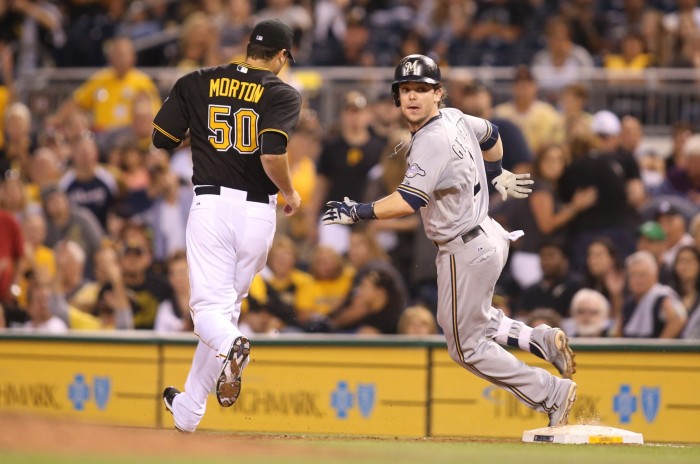Around this point of the offseason, despite the constant trades (and possibilities thereof), I often find myself growing bored. Yearning for the return of this beautiful game, I’ll peruse various leaderboards to learn more about an interesting metric or to discover some bizarre occurrence. This process brought me to one of the stranger elements of recent Brewers squads — and of one player in particular.
Scooter Gennett hasn’t accomplished much in his roughly three years in The Show. His career TAv sits at an uninspiring .264, and he hasn’t made up for that in the field. We really don’t know if he’ll make it through the coming Brewers rebuild. But we do know that, thus far, he’s done especially well in one obscure area of the game; and in doing so, he has made Milwaukee the best team in the majors in this regard. While it doesn’t begin to compensate for his deficiencies elsewhere, it nevertheless has enlivened us and brought us joy.
What sort of play have I described? This:
Most hitters don’t accomplish much on a ground ball. For Major League Baseball as a whole, only 23.6 percent of grounders go for base hits; a mere 7.7 percent of those hits are non-singles. Gennett, however, has up-ended that in his brief Major League stay. He’s reached base safely on 26.2 percent of his 366 ground balls, while 9.1 percent of his hits have gone for extra bases. Three of those have been the sort of play above, the rarest of breeds: a ground-ball triple.
Baseball certainly doesn’t lack entertainment. The emotion brought about by a towering home run, a brutal swinging third strike, or an outfield assist (hooray for self-promotion!) will get every observer’s heart racing. But the moment when a base runner rounds second, after the ball didn’t even travel through the air — few things can hope to top that. And in large part because of Gennett’s efforts, Milwaukee leads the majors in ground-ball triples over the last three years, with 15 — a mark that beats second-place Arizona by four.
Gennett himself has tied for the Major League lead over that same span, along with eight other men who have taken a third base three times. This has happened in spite of his limited playing time, which has given him the 181st-most grounders since 2013. On a rate basis, then, Gennett looks even better — among 238 hitters with 300 grounders in that time, he’s one of just seven with a ground-ball triple rate above 0.5 percent:
| Rank | Name | GB | 3B | 3B% |
|---|---|---|---|---|
| 1 | David Peralta | 317 | 3 | 0.9% |
| 2 | Scooter Gennett | 366 | 3 | 0.8% |
| 3 | Didi Gregorius | 388 | 3 | 0.8% |
| 4 | Carlos Gomez | 451 | 3 | 0.7% |
| 5 | Brandon Moss | 303 | 2 | 0.7% |
| 6 | Leonys Martin | 477 | 3 | 0.6% |
| 7 | Kevin Kiermaier | 326 | 2 | 0.6% |
(Note that Carlos Gomez also appears on this list. RIP.)
Obviously, a play such as this is incredibly fluky. Even the best players in the league will only accomplish it once out of every hundred chances at the absolute most. With that said, what Gennett has pulled off here deserves celebrating, not solely because he has done so little to warrant it, but because this is truly a fabulous play. I mean, just watch this:
And this:
Those are ground balls! Those shouldn’t even make it past the infielders, let alone go for an extra base — or two. Yet they did, on the strength of Gennett’s bizarre mix of grit and devil magic.
It’s not as though Gennett has put more power behind his grounders. Among the aforementioned 238-man sample, Gennett’s hard contact rate ranks 150th. He fares worse in terms of location, as his 47.3 percent pull rate comes in at 197th. For a lefty such as Gennett, hitting the ball to right field — which stretches out the throw to third — greatly increases the odds of a triple. This all suggests that he won’t keep this up, which means we should appreciate what he’s done to this point all the more.
Gennett hasn’t been alone in his ground-ball triple onslaught. In addition to him and Gomez, Jean Segura accrued two since 2013 began; Elian Herrera, Jason Rogers, Gerardo Parra, Nori Aoki, Shane Peterson, Jeff Bianchi, and Logan Schafer have each contributed one as well. Gennett simply stands out because (a) he’s done so more often and (b) he hasn’t done much else to distinguish himself. After sticking around at the highest level for this long, he should be able to call himself the best at something, no matter how narrow or esoteric.
As David Stearns continues to wheel and deal, Gennett might find himself on the move. If he ends up playing second or serving as a utility man for another team, maybe he’ll receive enough opportunities at the plate to further build his ground-ball triple resume. Whatever happens, we’ll always have the memories of one of the game’s weirdest plays, brought to us by an unlikely source.
